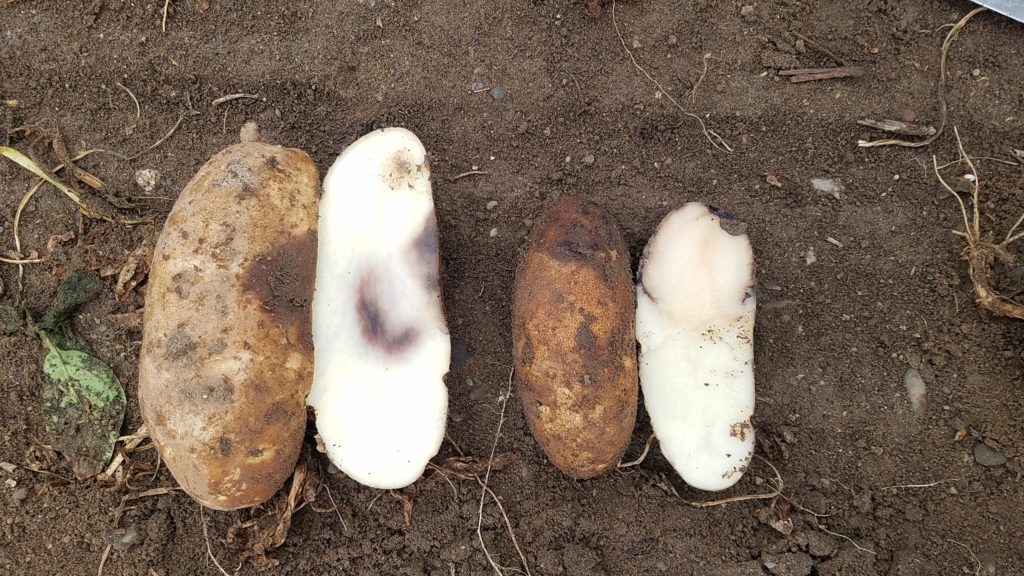
Improving phosphite performance for pink rot control
Pink rot, caused by the oomycete pathogen Phytophthora erythroseptica, can cause significant problems in potato production. Pink rot is typically more severe with short rotations and the use of susceptible varieties, such as Russet Norkotah and Clearwater Russet.
The pink rot pathogen normally infects the potato roots and stolons and then grows into the tuber. Most infections in tubers will originate at the stem end (Figure 1 above). This is different from Pythium leak, another disease which can appear similar to pink rot, which usually develops through eyes, lenticels or damaged tissue — like pink eye — in the field (Figure 1). Pythium infection in the field is not common, and most infections occur at harvest through wounded tissue.
Phosphite-based fungicides (phosphorous acid) have been effective tools for managing pink rot. This is especially true when populations of the pink rot pathogen are resistant to mefenoxam and metalaxyl. Unfortunately, phosphite fungicides are relatively weak with respect to the amount of active ingredient needed for disease control. Multiple applications of relatively high rates are required for phosphite fungicides to control pink rot infections in potato roots and tubers. Currently growers are advised to apply up to a total of 30 pints per acre in a season over three to six applications. This has been the most effective approach for varieties that are highly susceptible to pink rot, such as Russet Norkotah. The fungicide is taken up by the plant and translocated to the tubers where it provided protection against pathogen infection.
Recent work from scientists in Canada (Dr. Gefu Wang-Pruski and others) showed that phosphite uptake in potato plants increased for up to 52 hours after application. From this research, the question arose whether growers should maximize the time between phosphite fungicide application and irrigation to maximize uptake.
In other words, should growers wait 48 hours after application before turning the pivot back on? Under the semi-arid conditions present in many potato growing regions, this would not be difficult, if not impossible.
Trials
Field trials were conducted in 2018 and 2019 on Russet Norkotah to evaluate the effect of interval between phosphite fungicide application and irrigation. The trial area was infested with the pink rot pathogen at planting and again at hilling to increase disease pressure.
Treatments included:
- Untreated check (no fungicide)
- 48-hour interval between fungicide application and irrigation
- 24-hour interval
- 12-hour interval
- Six-hour interval
Phosphite fungicide (Resist 57, Actagro) was applied when the largest tubers were dime-size (about 15 millimeters in diameter), and again two more times using a two-week interval between sprays for three total applications.
In 2018, pink rot pressure was uniform in the trial area. Phosphite fungicide applications significantly reduced pink rot incidence at harvest if the application was made at least 12 hours prior to irrigation (Figure 2). Fungicide applications made only six hours before irrigation were statistically similar to the untreated check, but also similar to the other treatments. Application intervals of 24 and 48 hours were no more effective than applications made at 12 or six hours pre-irrigation.
When the trial was repeated in 2019, disease pressure was very low. Healthy tubers were collected at harvest and then challenged with the pink rot pathogen. This is an effective method to evaluate the uptake and protection granted by phosphite-based fungicides due to the systemic nature of the fungicide. In 2019, the six-hour interval treatment was not as effective as the 12-, 24-, or 48-hour interval treatments (Figure 3). Similar to the 2018 field data, no differences were observed among the 12, 24, and 48 hour interval treatments.
Longer interval pre-irrigation
Potato growers who are using phosphite-based fungicides can improve fungicide efficacy by allowing a 12-hour interval after application before starting irrigation. While this does require an additional layer of management, the improvement in fungicide performance merits taking that extra effort.
Growers do not need to wait 24 or 48 hours between application and irrigation to improve fungicide performance. This does not mean that phosphite uptake is not still occurring in the plant at those intervals, but that no improvement in performance is observed after a 12-hour interval.
Chemigation
Some growers have used chemigation to apply phosphite fungicides; on-farm field trials have shown that chemigation can be effective. Chemigation is typically done using the lowest water volume possible, usually close to 0.15 inches. The irrigation amounts after applications in these trial were between 0.57 and 0.76 inches of water. The low volume of water in the chemigation application may be low enough to allow phosphite to be taken up by the plant. Growers have reported that chemigating phosphites does not appear to be as effective as applying by airplane, however. More works needs to be done in this area.
When possible, delaying irrigation for at least 12 hours following phosphite fungicide applications will improve the performance of the fungicide program against pink rot.
— The information shared in this article was a collaborative effort between the staff at Miller Research in Rupert, Idaho, and researchers at the University of Idaho. Contributors include: Jeff Miller, Trent Taysom, Cheryn Clayton, Scott Anderson, Nora Olsen, Lynn Woodell, Andrew Hollingshead and Rabecka Henricks.
Top photo — Figure 1. The tuber on the left exhibits symptoms of pink rot. The pathogen has entered through the stolon end of the tuber. The infected tissue in cross-section has a creamy, off-white color with some dark tissue on the edge of the infected area. The tuber on the right shows symptoms of Pythium leak. The infection occurred on the side of the tuber. The infected tissue in cross-section is light to dark gray, and is wetter and darker than pink rot.









